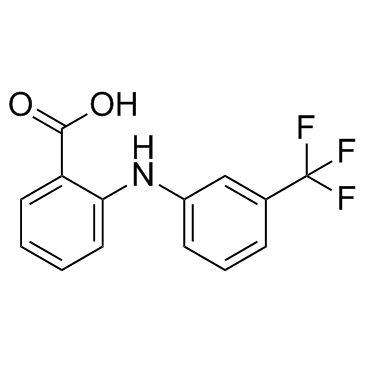Flufenamic Acid

Flufenamic Acid structure
|
Common Name | Flufenamic Acid | ||
|---|---|---|---|---|
| CAS Number | 530-78-9 | Molecular Weight | 281.230 | |
| Density | 1.4±0.1 g/cm3 | Boiling Point | 373.9±42.0 °C at 760 mmHg | |
| Molecular Formula | C14H10F3NO2 | Melting Point | 132-135 °C(lit.) | |
| MSDS | Chinese USA | Flash Point | 179.9±27.9 °C | |
| Symbol |

GHS06 |
Signal Word | Danger | |
|
Purinergic signaling via P2Y receptors up-mediates IL-6 production by liver macrophages/Kupffer cells.
J. Toxicol. Sci. 39(3) , 413-23, (2014) Resident macrophages in the liver (Kupffer cells) produce various cytokines and chemokines, and have important roles in hepatitis and liver fibrosis. The cells are activated by various factors, for example lipopolysaccharide (LPS), which is an endotoxin and i... |
|
|
Cheminformatics analysis of assertions mined from literature that describe drug-induced liver injury in different species.
Chem. Res. Toxicol. 23 , 171-83, (2010) Drug-induced liver injury is one of the main causes of drug attrition. The ability to predict the liver effects of drug candidates from their chemical structures is critical to help guide experimental drug discovery projects toward safer medicines. In this st... |
|
|
Convenient QSAR model for predicting the complexation of structurally diverse compounds with β-cyclodextrins
Bioorg. Med. Chem. 17 , 896-904, (2009) This paper reports a QSAR study for predicting the complexation of a large and heterogeneous variety of substances (233 organic compounds) with beta-cyclodextrins (beta-CDs). Several different theoretical molecular descriptors, calculated solely from the mole... |
|
|
Developing structure-activity relationships for the prediction of hepatotoxicity.
Chem. Res. Toxicol. 23 , 1215-22, (2010) Drug-induced liver injury is a major issue of concern and has led to the withdrawal of a significant number of marketed drugs. An understanding of structure-activity relationships (SARs) of chemicals can make a significant contribution to the identification o... |
|
|
A predictive ligand-based Bayesian model for human drug-induced liver injury.
Drug Metab. Dispos. 38 , 2302-8, (2010) Drug-induced liver injury (DILI) is one of the most important reasons for drug development failure at both preapproval and postapproval stages. There has been increased interest in developing predictive in vivo, in vitro, and in silico models to identify comp... |
|
|
Effect of monoacyl phosphatidylcholine content on the formation of microemulsions and the dermal delivery of flufenamic acid.
Int. J. Pharm. 479(1) , 70-6, (2015) The choice of appropriate excipients is crucial for the success of a dermal drug delivery system. Especially surfactants should be chosen carefully, because of their possible interactions with the skin or the applied drug. Since monoacyl phosphatidylcholine (... |
|
|
Influence of the composition of monoacyl phosphatidylcholine based microemulsions on the dermal delivery of flufenamic acid.
Int. J. Pharm. 475(1-2) , 156-62, (2014) Although microemulsions are one of the most promising dermal carrier systems, their clinical use is limited due to their skin irritation potential. Therefore, microemulsions based on naturally derived monoacyl phosphatidylcholine (MAPL) were developed. The in... |
|
|
A combined spectroscopic and crystallographic approach to probing drug-human serum albumin interactions.
Bioorg. Med. Chem. 18 , 7486-96, (2010) The displacement of probes that bind selectively to subdomains IIA or IIIA on human serum albumin (HSA) by competing compounds has been followed using fluorescence spectroscopy, and has therefore been used to assign a primary binding site for these compounds ... |
|
|
Preparation and characterization of uniform particles of flufenamic acid and its calcium and barium salts
J. Colloid. Interface Sci. 381(1) , 198-201, (2012) Graphical abstract [Display omitted] |
|
|
Development of a phospholipidosis database and predictive quantitative structure-activity relationship (QSAR) models.
Toxicol. Mech. Methods 18 , 217-27, (2008) ABSTRACT Drug-induced phospholipidosis (PL) is a condition characterized by the accumulation of phospholipids and drug in lysosomes, and is found in a variety of tissue types. PL is frequently manifested in preclinical studies and may delay or prevent the dev... |